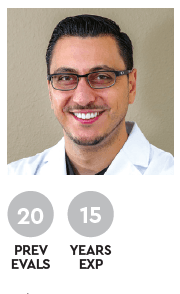A versatile, flowable, light-cured composite available in both low and regular viscosities for a wide variety of dental procedures

"The speed of placement reduces chair time and improves patient comfort. "
James Yang, DDS
Woodland, CA

"Patients with high esthetic demands will be pleased with the finish. "
Nilay Nanavati, DDS
Lindenhurst, NY

"It is easy to match the shade and has good consistency. "
Varo Boyer, DDS, FICOI
Simi Valley, CA

Just as teeth come in many shapes, shades, and sizes, dental composites are developed with a variety of consistencies, colors, and compositions, with the average general practice relying on universal, bulk fill, and flowable materials every single day. While each has its own indications and benefits, flowable composites in particular offer a versatile and minimally invasive solution for a wide range of dental challenges—from sealing microscopic nooks and crannies to lining cavities and crafting intricate restorations.
Hoping to solve some of his dental challenges with a flowable composite “that handles well, matches in color, and polishes to a high finish,” Dr. Jeffrey Greene put Patterson Dental’s Flowable Composite to the test and was extremely satisfied with its performance.
“Much to my surprise, the Patterson Flowable Composite flowed and stayed where it was placed, the color blended in, and it polished to a nice finish,” declared Dr. Greene. “It was nice having this product to choose from for small, cosmetic restorations.” Esthetically, he said, “It competes well with one-shade-fits-all composites. The overall ease of use and final restorations were excellent.”
Versatility
Available in Low Viscosity and Regular Viscosity formulas, the Patterson Flowable Composite is a versatile solution for an array of dental procedures. It is indicated for Class I, II, III, and IV restorations; as a sealant and cavity liner; for abrasions, splinting, abfractions, defect and temporary repairs, and minor core buildups; and to cover stains, cement veneers, and block out undercuts. The light-cured material has high radiopacity and high flexural and compressive strengths.
“The Regular Viscosity material was good as a glaze or polish after adjusting the restoration, and the Low Viscosity was a good liner,” said Dr. Kalpesh Mehta. Pleased to “find a universal flowable to use for a variety of procedures,” Dr. Clyde Ono said it performed well “for small Class III fillings, pit and fissure fillings, orthodontic retainers, and as a wetting agent for fiber-bonded bridges.” Dr. Steven Hever called it a “trusty flowable for a Class II composite box before placing composite or as a base for buildups,” and Dr. Carl Sakamaki said, “It worked very well in pediatric quadrant dentistry, for endo buildups, and for sealing access.”
Reporting success when treating a patient’s abfractive lesion that was causing dentin hypersensitivity, Dr. Nilay Nanavati shared, “The patient noted a significant decrease in sensitivity and was pleased with the esthetic outcome.” Calling it a “quick, strong, temporary patch material for broken teeth,” Dr. Carlos Boudet said it also worked well “as a liner in restorations to eliminate sensitivity.”
Viscosity, Handling, & Adaptability
Both viscosities are dispensed in a 2-g syringe and injected directly into the cavity preparation for maximum adaptation. The Low Viscosity has a thin, fluid consistency that flows easily and adapts well to small cavities and in tight spaces. It also can be used as a liner or base. With a slightly thicker consistency, the Regular Viscosity is thixotropic and flows well under pressure while providing some structural support for easy handling and manipulation.
The Patterson Flowable Composite “adapts well to the cavity prep due to the flowable nature of the product, and the speed of placement reduces chair time and improves patient comfort,” said Dr. James Yang. Appreciating the choice of viscosity, Dr. Mehta experienced “good flow and polish” but felt the Regular Viscosity was a bit too runny. Calling it “easy to dispense and use,” Dr. Nanavati said, “It was slightly less viscous than comparable materials I’ve used.”
Dr. Ono said he did not experience any air bubbles with either formula. “It is easy to use, dense, and flowable, which is great for day-to-day applications,” shared Dr. Hever.
Esthetics
Both the Low Viscosity and Regular Viscosity are available in 6 shades—A1, A2, A3, A3.5, 2XB, and Incisal. “It is easy to match the shade, has good consistency, is very polishable, and exhibits natural-looking blending to existing tooth structure,” said Dr. Varo Boyer. Using this composite “makes my work faster and more efficient since I need to make fewer adjustments, spend less time polishing, and do not have to go back and redo anything because the shade and tone match well,” he added.
Dr. Boudet said the Patterson composite “had better opacity” than his previous flowable. Appreciating the “excellent shade match” and a smooth chairside experience, Dr. Nanavati concluded, “Patients with high esthetic demands will be pleased with the finish.”
Overall Satisfaction
Praising Patterson Flowable Composite’s “ease of use, quick adaptation to walls and margins, and very nice shade match and polish,” Dr. Sakamaki declared, “It made my work much more efficient and resulted in a better patient experience.”
Takeaways
- Light-cured, flowable composite in choice of Low Viscosity or Regular Viscosity
- Dispensed in a 2-g syringe and injected directly into the cavity prep
- Available in 6 shades— A1, A2, A3, A3.5, 2XB, and Incisal
- A versatile solution for an array of dental procedures
- Features high radiopacity and high flexural and compressive strengths






